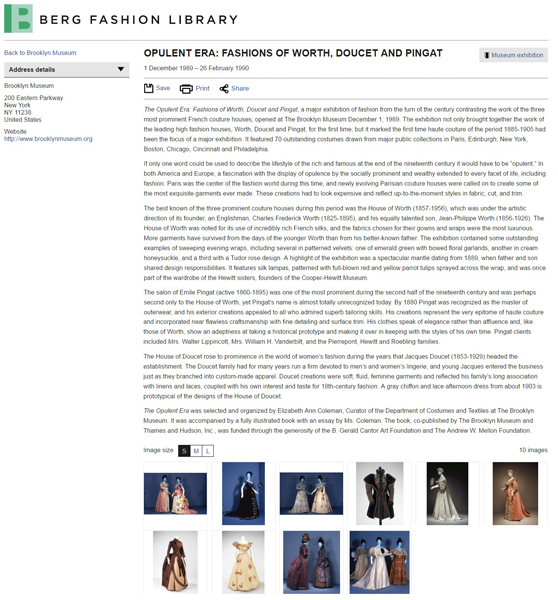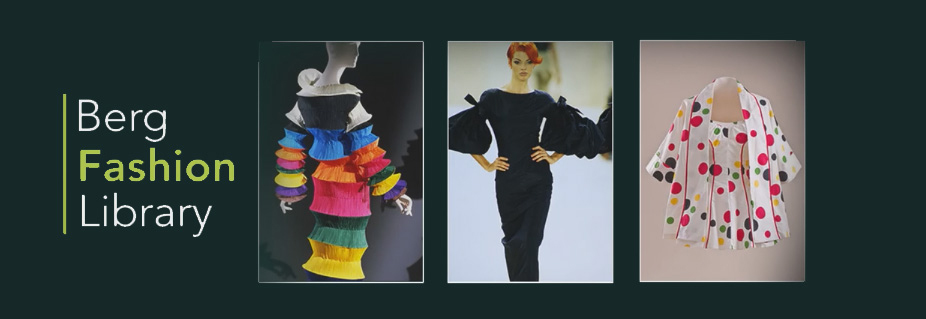- Volume 47 | Permalink
First launched in 2010, the Berg Fashion Library is a subscription product that offers a broad range of text and image resources on dress from across cultures and throughout history. These materials range from e-books to essays, reference works to bibliographic guides, lesson plans to museum directories, exhibition documentation, and more than thirteen thousand images of artworks from museum collections around the world. The Library forms one third of Bloomsbury Fashion Central and is widely considered an essential platform for fashion research and education.[1] Along with the Berg Fashion Library, Bloomsbury Fashion Central includes the Fashion Photography Archive, a repository for forty years of contemporary fashion photography. The Berg Fashion Library is available via subscription to Bloomsbury Fashion Central or via independent subscription.
The Bloomsbury Fashion Central search module allows users to search the Berg Fashion Library and the Fashion Photography Archive simultaneously; ensuing search results are compiled from both portals. The Berg Fashion Library’s content is also accessible through a refined search on the Bloomsbury Fashion Central main page, as well as on the Library’s main page (fig. 1). In the latter instance, users may search the individual sections that compose the Library, such as The Encyclopedia of World Dress and Fashion, a digital version of the ten-volume reference work that offers a cross-cultural exploration of the dressed and adorned body throughout history, or the “Museum Directory,” which lists dress collections in museums around the world, with notes on collection strengths and specialties. The Library’s content is easily accessible thanks to the relaunch of this website on a revitalized platform with state-of-the-art functionality and optimal search technology in 2016. For nascent users of the Bloomsbury Fashion Central platform, a “How to Use” guide provides information on the features, content, and functionality of its products, including the Berg Fashion Library.
In addition to single essays and articles, the Berg Fashion Library contains an abundance of e-books and major reference texts. The “eBooks” module includes more than ninety Bloomsbury fashion titles, which range from theoretical discourses on fashion to wide-ranging fashion surveys. The “Reference Works” area boasts content from A–Z of Fashion, edited by Valerie Steele, a benchmark text that provides information on designers and clothing styles, and The Dictionary of Fashion History, by Valerie Cumming, C. W. Cunnington, and P. E. Cunnington, a standard volume for fashion terminology (fig. 2).
Further reference materials are found in the Library’s “Biblio Guides”—short for bibliographic guides—which present key readings and schools of thought on a variety of thematic subjects, ranging from “Fashion and Sociology” to “Dress and Religion.” Like many areas of the Berg Fashion Library, content in this area is cross-linked to other areas of the website; for example, live links in the guides take subscribers to related articles and e-book chapters found elsewhere in the Library. In addition to the “Biblio Guides,” live links are available—and are especially helpful—in the Library’s “Lesson Plans” area. These plans were developed to help lecturers and teachers plan their courses, and they are provided free of charge to Library subscribers and nonsubscribers alike. As a benefit of subscription, subscribers are able to click through the plans’ links to efficiently source additional reference and learning resources that are hosted in other parts of the Library.
As the Berg Fashion Library is updated on an ongoing basis, its content has grown tremendously over the past seven years. New areas of the website demonstrate an anticipation of user needs, as seen, for example, in the recently launched “Museum Exhibitions” page. Costume and textiles exhibitions are held by museums and institutions around the world, and it is often difficult to visit installations that are far afield. The “Museum Exhibitions” section attempts to rectify this challenge by providing installation and object images, as well as curatorial texts, from seminal past fashion exhibitions—such as Elizabeth Ann Coleman’s landmark exhibition, Opulent Era: Fashions of Worth, Doucet and Pingat (Brooklyn Museum, December 1989–February 1990). In the exhibition, Coleman compared and contrasted the work of three preeminent late nineteenth-century couturiers; the Berg Fashion Library repository features a seven-hundred-word text about the show with ten accompanying images that showcase fifteen garments (fig. 3). This area would be an excellent section for growth, as it presently features about a dozen exhibitions from a handful of museums.
 Figure 3. Berg Fashion Library “Museum Exhibitions” page for Opulent Era: Fashions of Worth, Doucet and Pingat, accessed June 12, 2017
Figure 3. Berg Fashion Library “Museum Exhibitions” page for Opulent Era: Fashions of Worth, Doucet and Pingat, accessed June 12, 2017While the Berg Fashion Library is generally user-friendly, there is room for improvement in the way some content is formatted, as occasionally some areas of the website seem to assume that the user has existing knowledge of fashion scholarship. For example, “Classic and Modern Writings on Fashion” contains seminal essays by prominent intellectuals such as the American sociologist Thorstein Veblen (1857–1929) and the German philosopher Georg Simmel (1858–1918) (fig. 4). Many of these texts form the foundation of fashion theory and methodology. Unfortunately, the landing page for this section lists the essays solely by title, without author or publishing information, making it difficult to immediately identify these texts. It is only by clicking an individual title that one learns, for example, that “The Medieval Aesthetic Sensibility” was written by the Italian philosopher and semiotician Umberto Eco (1932–2016) and published in Beauty in the Middle Ages by Yale University Press in 1986. Similar formatting appears in the aforementioned “eBooks” module, where the e-books are listed solely by partial title.
Perhaps the Library’s most important resources are the sections for its image bank and digital rendering of The Encyclopedia of World Dress and Fashion. In contrast to the specialized nature of the Library’s other resources, these modules allow for comprehensive exploration of dress and fashion. (Of course, broad searching across all areas of the Berg Fashion Library is also available by entering one’s search terms on the Bloomsbury Fashion Central main page and then narrowing the search to the Library.) The Library’s image bank contains more than thirteen thousand images from museum collections around the world, as well as from Kerry Taylor Auctions and the Commercial Pattern Archive (CoPA) (fig. 5). While many of these images are derived from the collections of large museums whose holdings are already accessible to the public via institutional websites, by its centralization this repository reduces the need for researchers to seek objects across many different websites. Those who search for images on Bloomsbury Fashion Central are able to pull object and runway visuals simultaneously from the Berg Fashion Library’s image bank and from the Fashion Photography Archive, which can be filtered by year and season. As mentioned, The Encyclopedia of World Dress and Fashion section is a searchable digital version of the important ten-volume reference work on global dress and fashion. As an additional subscription benefit, subscribers to Berg Fashion Library have access to a selection of additional articles that were specially commissioned for the Library’s Encyclopedia.
The diversity of content available on the Berg Fashion Library attests to its ability to serve a wide variety of research needs. Indeed, its varied resources are ideal for students and experts alike, as they provide both essential information on fashion and dress as well as specialized content for in-depth studies and research.
The Berg Fashion Library has been the subject of much critical acclaim as well as the recipient of many prestigious awards. See “Bloomsbury Fashion Central – Praise for Berg Fashion Library,” Bloomsbury Fashion Central, accessed June 4, 2017, https://www.bloomsburyfashioncentral.com/about/awards-and-reviews.

Ars Orientalis Volume 47
Permalink: https://doi.org/10.3998/ars.13441566.0047.015
For more information, read Michigan Publishing's access and usage policy.






